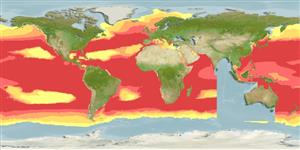Common names from other countries
Environment: milieu / climate zone / depth range / distribution range
Ecologia
marinhas; oceanódromo (Ref. 51243). Subtropical
Circumglobal in tropical and warm temperate seas.
Tamanho / Peso / Idade
Maturity: Lm ? range ? - ? cm
Max length : 50.0 cm TL macho/indeterminado; (Ref. 55763); common length : 25.0 cm TL macho/indeterminado; (Ref. 55763)
Espinhos dorsais (total) : 0; Raios dorsais moles (total) : 27 - 34; Espinhos anais: 0; Raios anais moles: 25 - 34. Body cylindrical and elongate; possessing an oblong cephalic disk with 14 to 17 transverse laminae; cranium depressed (supporting cephalic disk); dorsal fin with 27 to 44 rays; first gill arch with fewer than 21 gill rakers; body entirely white to pale blue (Ref. 55763).
Found on the body and inside gill chamber of billfishes and swordfishes, rarely on any other fishes (Ref. 2850); also in the gill cavities and mouths of sharks (Ref. 5951).
Life cycle and mating behavior
Maturities | Reprodução | Spawnings | Egg(s) | Fecundities | Larvas
Paxton, J.R., D.F. Hoese, G.R. Allen and J.E. Hanley, 1989. Pisces. Petromyzontidae to Carangidae. Zoological Catalogue of Australia, Vol. 7. Australian Government Publishing Service, Canberra, 665 p. (Ref. 7300)
Categoria na Lista Vermelha da IUCN (Ref. 130435)
CITES (Ref. 128078)
Not Evaluated
Ameaça para o homem
Harmless
Utilização humana
Ferramentas
Relatórios especiais
Descarregue XML
Fontes da internet
Estimates based on models
Preferred temperature (Ref.
115969): 7.9 - 28.1, mean 23.4 (based on 1998 cells).
Phylogenetic diversity index (Ref.
82804): PD
50 = 0.5352 [Uniqueness, from 0.5 = low to 2.0 = high].
Bayesian length-weight: a=0.00263 (0.00112 - 0.00620), b=3.17 (2.96 - 3.38), in cm Total Length, based on LWR estimates for this (Sub)family-body shape (Ref.
93245).
Nível Trófico (Ref.
69278): 3.5 ±0.4 se; based on size and trophs of closest relatives
Resiliência (Ref.
120179): Médio, tempo mínimo de duplicação da população 1,4 - 4,4 anos (Assuming Fec < 10,000).
Fishing Vulnerability (Ref.
59153): Moderate vulnerability (40 of 100).
